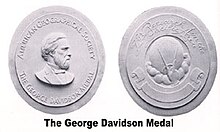George Davidson Medal

The George Davidson Medal is awarded by the American Geographical Society for the "exceptional achievement in research for exploration in the Pacific Ocean or the lands bordering therein".[1] In 1946, the American Geographical Society received a bequest of $5000 from his daughter Ellinor Campbell Davidson to establish the medal and a research fund to honor her father. The medal was designed by American sculptor Paul Manship in 1951.[2]
History[]
George Davidson was a geographer and scientist noted for his work with the U.S. government exploring and charting the western United States and Alaska. Davidson was a geodist for the U.S. Coast and Geodetic Survey, working heavily in the Pacific waters. He later became a professor at the University of California.[2] In 1907, he published The Discovery of San Francisco Bay.
Recipients[]
Source: American Geographical Society
- 1952: George Babcock Cressey
- 1972: F. Raymond Fosberg
- 1974:
- 1975:
- 1988:
- 1999: Hou Renzhi
- 2001: David Stoddart
See also[]
References[]
- ^ "George Davidson Medal". American Geographical Society. Archived from the original on 2014-02-25. Retrieved 2010-06-17.
- ^ a b Wright, John Kirtland 'The Years of Henry Grinnell', Geography in the Making: The American Geographical Society 1851-1951 (1952) pp. 14–70. — [George Grady Press]
Further reading[]
- "The World Its Oyster". The New York Times. 1952-06-01.
- "Geographers Sift Point Four Factors". The Christian Science Monitor. 1952-08-09.
- "Five Geographers to Receive Medals". The New York Times. 1952-07-21.
External links[]
- Awards of the American Geographical Society
- Awards established in 1946
- 1946 establishments in the United States
- Works by Paul Manship